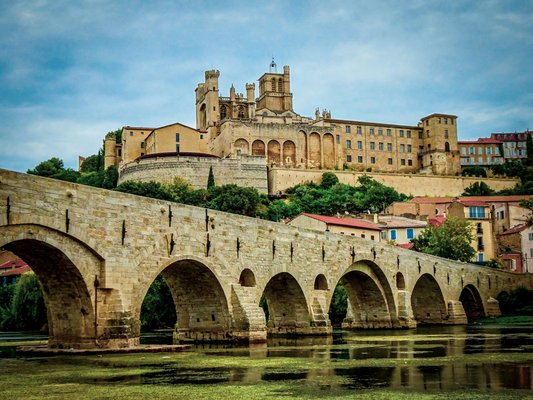This Mediterranean port city sits between sea and lagoon, with a network of canals, water jousting traditions, and fresh seafood markets. Known for its tielle pies and oyster farms.
Sète, a port city in southern France, sits between the Mediterranean Sea and the Thau Lagoon. You can climb Mont Saint-Clair for views of the city and sea, watch water jousting tournaments in the canals, or visit museums dedicated to local artists like poet Paul Valéry. The city's restaurants serve seafood specialties, including tielle pies and fresh oysters from the nearby lagoon.
Exploring Sète's Canals and Old Port
Sète's network of canals has earned it the nickname "Venice of Languedoc." You can walk along the Canal Royal and see fishing boats and pleasure craft passing under low bridges. The Old Port is at the center of Sète, with buildings in various colors lining the quays. Here you'll find fishmongers selling their daily catch and cafes where you can drink pastis while watching boats come and go.
Views from Mont Saint-Clair
For a panorama of Sète and its surroundings, go to the top of Mont Saint-Clair. This 175-meter hill rises behind the city, giving you views of the Mediterranean Sea, the Thau Lagoon, and the city's canals below. You can walk up steep streets with artists' workshops or drive to the summit. At the top, visit the Notre-Dame-de-la-Salette chapel to see its modern frescoes.
Beaches and Coastal Activities
Sète has 12 kilometers of sandy beaches along a narrow strip of land called the Lido. The beaches closest to the city center, like Plage de la Corniche, are often crowded. For a calmer experience, go further west to beaches like Plage des Trois Digues. You can try windsurfing, kitesurfing, or stand-up paddleboarding in the calm waters of the Thau Lagoon.
Local Cuisine and Seafood Specialties
Sète's food reflects its connection to the sea. Try the city's signature dish, tielle, an octopus and tomato pie originally brought by Italian immigrants. You can also taste fresh oysters and mussels from the Thau Lagoon, often served simply with lemon. For dessert, try zezettes, boat-shaped cookies flavored with vanilla and local white wine. You can find these foods at the covered market, Les Halles, or at restaurants along the canals.
Museums and Cultural Attractions
Learn about Sète's artistic history at the Musée Paul Valéry, dedicated to the famous poet born in the city. The museum displays Valéry's manuscripts and personal items, as well as works by other artists connected to Sète. For a different perspective, visit the Musée International des Arts Modestes (MIAM), which presents everyday objects as art. If you like music, check the schedule at the open-air Théâtre de la Mer, a former fortress that now hosts concerts with the Mediterranean as a backdrop.
Water Jousting Tradition
Sète's most distinctive tradition is water jousting, a sport that dates back to the city's founding in 1666. During summer months, especially around the Fête de la Saint-Louis in August, you can watch jousters on raised platforms of blue and red boats trying to knock each other into the canal using long lances. The tournaments draw many spectators and include music and celebrations along the quays.
Getting to and Around Sète
You can reach Sète by train, with direct services from Paris, Montpellier, and other major cities. Once in Sète, you can walk to many places in the city center. For longer distances, local buses go to the beaches and outskirts. Boat tours let you see the city from its canals and the lagoon. Renting a bike is also a good option, especially for exploring the long stretch of beaches on the Lido.


















